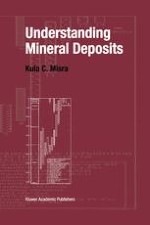
2000 | OriginalPaper | Chapter
Introduction
Author : Kula C. Misra
Published in: Understanding Mineral Deposits
Publisher: Springer Netherlands
Included in: Professional Book Archive
Activate our intelligent search to find suitable subject content or patents.
Select sections of text to find matching patents with Artificial Intelligence. powered by
Select sections of text to find additional relevant content using AI-assisted search. powered by
A mineral deposit (or an ore deposit) may be defined as a rock body that contains one or more elements (or minerals) sufficiently above the average crustal abundance to have potential economic value. It has been a common practice to classify mineral deposits into two broad categories: (a) metallic mineral deposits (e.g., deposits of copper, lead, zinc, iron, gold, etc.), from which one or more metals can be extracted; and (b) nonmetallic (or industrial) mineral deposits (e.g., deposits of clay, mica, fluorite, asbestos, garnet, etc.), which contain minerals useful on account of their specific physical or chemical properties. The minerals of economic interest in a deposit are referred to as ore minerals and the waste material as gangue. Accessory sulfide-group and oxide-group minerals (e.g., pyrite, arsenopyrite, magnetite, ilmenite), especially in metallic mineral deposits, however, are sometimes described as ore minerals, although they actually constitute part of the gangue.